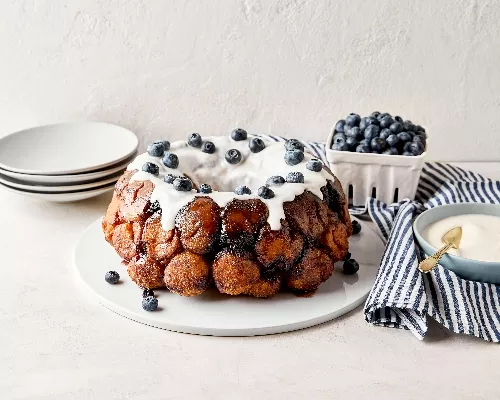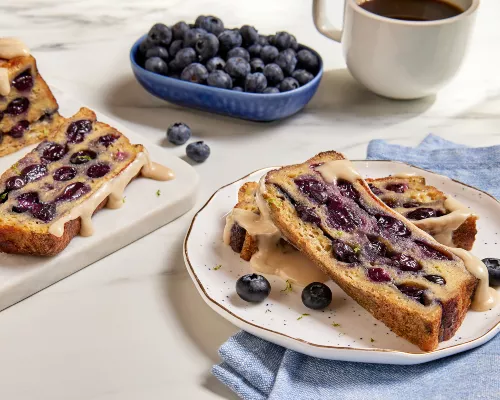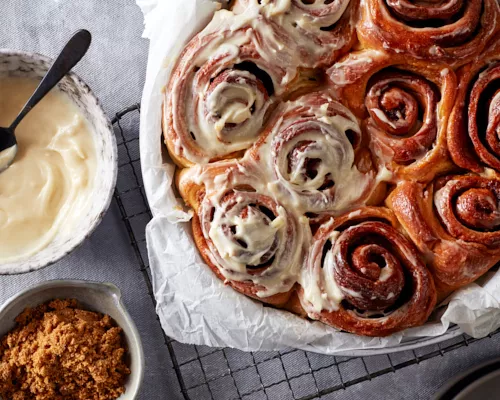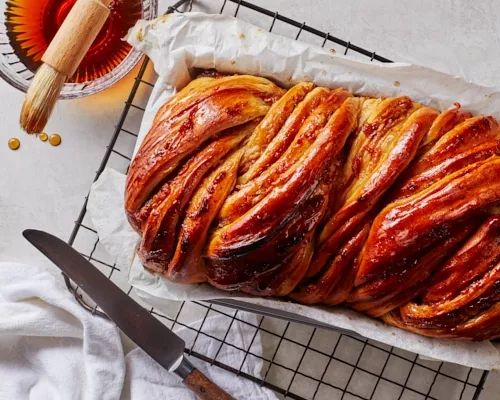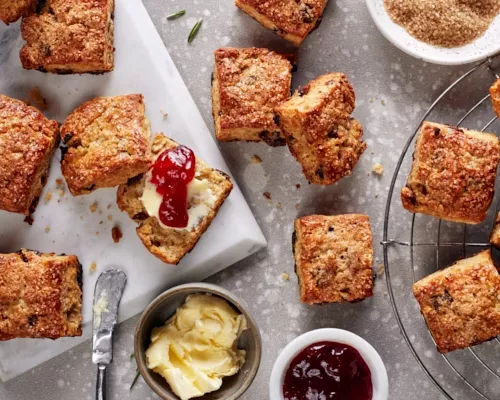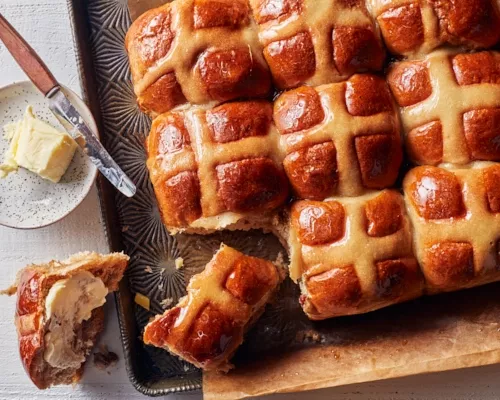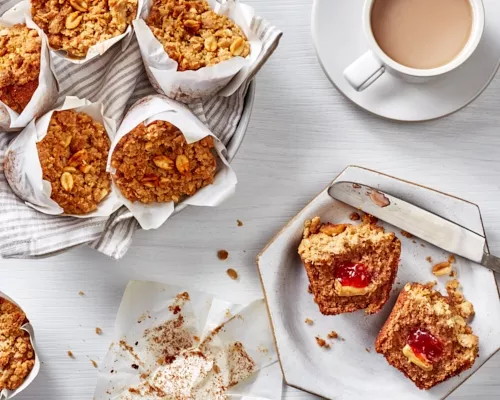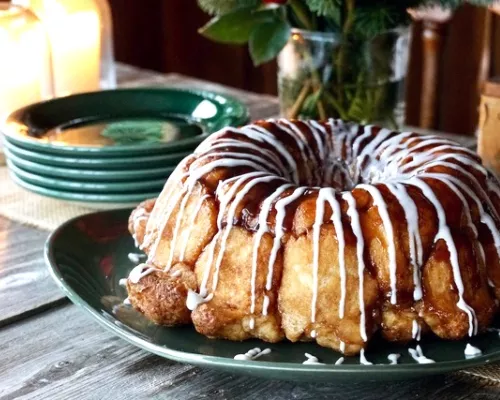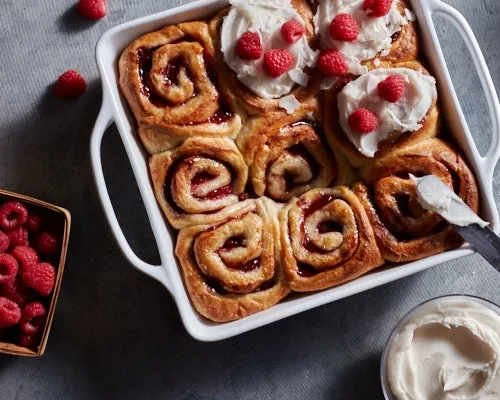Step 1
Warm milk and butter together in a microwave-safe bowl (or liquid measuring cup). Heat on high at 15– to 20–second intervals until milk is at least 110°F (43°C) but no higher than 115°F (46°C). Cool to 110°F (43°C) if milk gets too hot.
Step 2
Transfer to the bowl of a stand mixer fitted with the paddle attachment or to a large bowl. Sprinkle in the instant yeast and stir to dissolve. Let sit until mixture is foamy; 5 to 10 minutes.
Step 3
Add the Redpath® Dark Brown Sugar and mix on low speed (or stir with a rubber spatula or wooden spoon); 5 to 10 seconds.
Step 4
Add 1 cup (120 grams) of bread flour, lightly beaten egg, and salt, and mix on low speed. Once fully combined, add the next cup of flour and mix until combined before adding the third cup of flour. Once the dough becomes difficult to mix, switch to a dough hook. If the dough is still wet, add the last ¼ cup (30 grams) of flour. Cover the bowl and let dough rest; 15 minutes. This allows the flour to hydrate and relax, making it easier to knead the dough.
Step 5
Knead the dough (or lightly flour your work surface and transfer dough to the floured surface to knead with your hands) until it’s soft but tacky; 5 to 10 minutes. Shape the dough into a ball.
Step 6
Lightly oil the stand mixer bowl or the large bowl used when mixing the dough. Place the dough rounded side down first, and flip it over to ensure the dough is lightly greased; this prevents the dough from sticking to the plastic wrap or damp, lint-free kitchen towel placed over the bowl. Allow the dough to bulk ferment by placing the covered bowl in a warm, draft-free location to rise until doubled in size; approximately 45 minutes (see Chef’s Tips).
Step 7
Lightly grease a 9 x 13-inch pan and line with parchment paper.
Step 1
Place butter into a small microwave-safe bowl. Heat for 10 seconds until butter is very soft and spreadable; do not melt.
Step 2
In a small bowl, whisk together the Redpath® Dark Brown Sugar, ground cinnamon, and salt.
Step 1
Punch down the dough, and transfer it to a lightly floured work surface. Roll into an 18 x 10-inch rectangle (dough should be an even thickness; about ¼-inch thick). If the dough keeps contracting while rolling, cover with plastic wrap and allow the gluten in the dough time to relax (see Chef’s Tips).
Step 2
The long edge (18-inch) of the rolled-out dough should be parallel to the edge of your work surface. Spread the butter onto the rolled-out dough, leaving about ½ inch free of butter at the furthest end.
Evenly sprinkle the cinnamon sugar over the surface of the butter. Gently rub and pat the sugar mixture into the butter, being careful not to tear or stretch the dough. After sprinkling the surface with cinnamon sugar, lightly brush the free edge with some water before rolling dough into a tight log. Pinch the seam together when you reach the dampened edge (see Chef’s Tips for how to make into heart-shaped rolls).
Step 3
With the seam side down, slice the log using a length of unflavoured dental floss (or thread). Slide the floss under the roll 2 inches from one of the ends, cross the two ends at the top of the roll and pull tightly in opposite directions until the floss cuts through the roll. Repeat the process at 2-inch intervals until the entire roll is cut.
Step 4
Arrange the 9 rolls in the prepared baking pan, spaced evenly apart. Cover with plastic wrap or a damp kitchen towel. Place in a warm, draft-free location to proof until almost doubled in size; about 30 to 35 minutes. To check if the rolls are ready for baking, perform the poke test (see Chef’s Tips).
Step 5
Halfway into the proofing time, preheat oven to 350°F (177°C).
Step 6
Place cinnamon rolls into the preheated oven; 25 to 30 minutes. Rotate pan halfway through the baking time. Continue baking until a thermometer reads just below 190°F (88°C) at the centre of the pan. Do not overbake, or the rolls will be dry.
Step 7
While the rolls are baking, make the icing.
Step 1
In the bowl of a stand mixer, using the paddle attachment, cream together the cubed cream cheese and butter on medium speed until smooth and creamy. Add in the vanilla extract and salt. Mix to combine thoroughly. Add the Redpath® Icing Sugar and mix on low speed until just combined. Scrape down the sides of the bowl and increase speed to medium, and beat until fluffy; about 3 minutes.
Step 2
Remove the finished rolls from the oven and place onto a wire cooling rack to cool slightly; 5 minutes.
Step 3
Use a small offset spatula to spread ⅓ cup of the icing over the tops of the warm cinnamon rolls. Cool cinnamon rolls to room temperature; 20 minutes. Spread or pipe the remaining icing over the cinnamon rolls. Serve immediately.
Step 4
Any leftover rolls can be stored in an airtight container for up to 2 days at room temperature, a week in the fridge, or up to 2 months in the freezer (see Chef’s Tips).
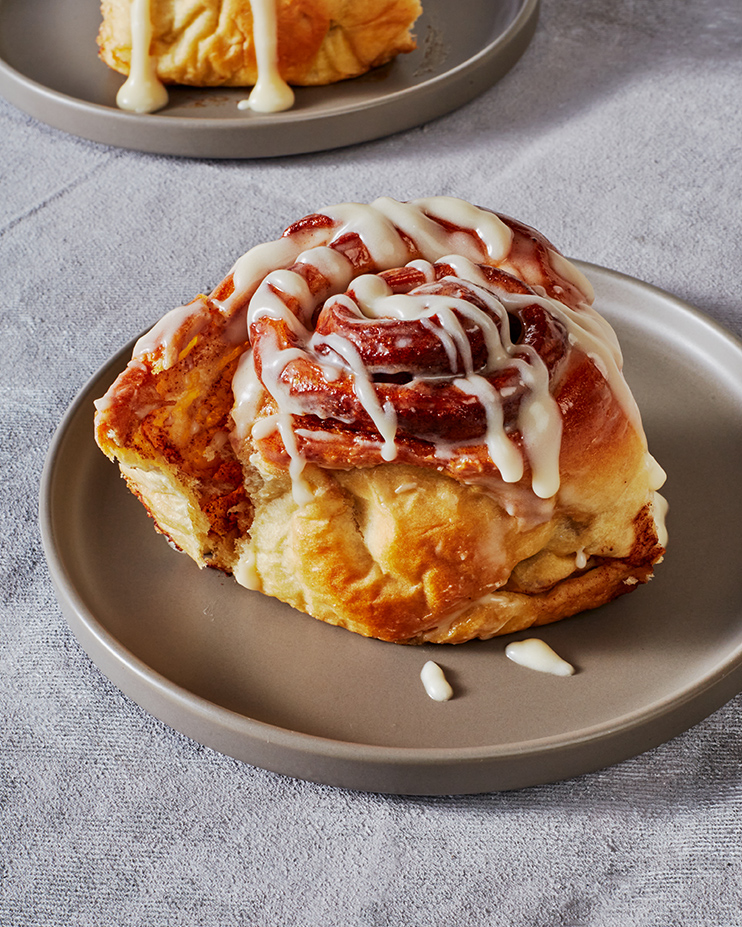
*Ensure all ingredients are at room temperature before proceeding with the recipe unless otherwise stated.
*The warmth of your kitchen and ingredients used will determine how long it takes the dough to double in size (e.g. a cold kitchen may result in the dough taking 2 hours to double).
*Active dry yeast can be used in place of instant yeast; however, the rise times will be longer.
*If desired, use ⅔ cup of any of our Cinnamon Sugar 3 Ways recipes, adding the salt to the mixture.
*For heart-shaped rolls:
- Evenly spread the softened butter over the entire surface of the rolled-out dough with a small offset spatula or rubber spatula. After sprinkling the dough with the cinnamon-sugar mixture, use the tip of a paring knife to mark the dough at the halfway point (5 inches) on the short edges.
- Starting at the long edge closest to the edge of the work surface, roll the dough into a tight log towards the 5-inch mark. Stop rolling when it is reached.
- Carefully rotate the dough so that the remaining unrolled long edge is closest to the edge of the work surface. Roll the dough into a tight log, meeting the other log in the middle. Cut the log, with the “bumps” facing upwards using the method stated in the recipe.
- Carefully lay each roll on its side; you may need to unroll each bump of the “heart” slightly to create a more pronounced “V”. Pinch the bottom of each roll into a point, forming a heart-shaped roll.
*Overnight rolls: Make the cinnamon rolls up to where the rolls are placed into the baking pan. Cover with plastic wrap. Instead of placing the rolls in a warm place to rise, place them in the fridge (between 8 to 12 hours). Remove from the fridge and place into a warm, draft-free location to come to room temperature; approximately 1 hour. Proceed with the remaining steps.
*Poke test: Poke the rolls with a floured or oiled finger. It is ready to be baked when the indentation slowly fills back in. The rolls are over-proofed if the indentation remains and does not fill back in. Rolls will need a few more minutes of proofing if the indentation fills immediately back in. This test can be done on any yeasted product.
*Always allow cinnamon rolls stored in the fridge to come to room temperature (or reheat) before eating.
*To quickly reheat a single serving, place a roll onto a microwave-safe plate and cover with a damp paper towel. Reheat at 10-second intervals until heated through. Serve immediately.
*If you plan on freezing the finished cinnamon rolls, freeze once the cinnamon rolls are completely cooled and, ideally, iced when you plan to eat them. Let cinnamon rolls thaw in the fridge overnight. Place the cinnamon rolls (1 or more) onto a baking sheet or baking pan lined with parchment and sprinkle the tops with water. Cover with foil and reheat for 10 to 15 minutes. Remove and allow to cool slightly before spreading each roll with a small amount of icing, allowing the icing to melt into the roll. Spread or pipe more icing on each roll after cooling to room temperature.
*Redpath® Golden Yellow or Redpath® Demerara Style Sugar can be used in place of the Redpath® Dark Brown Sugar. Note that the resulting cinnamon rolls may be lighter in colour and caramel flavour if using the Redpath® Golden Yellow Sugar. If using the Redpath® Demerara Style Sugar, the rolls will be darker in colour and have more of an earthy flavour and a stronger undertone of caramel in the final result.


